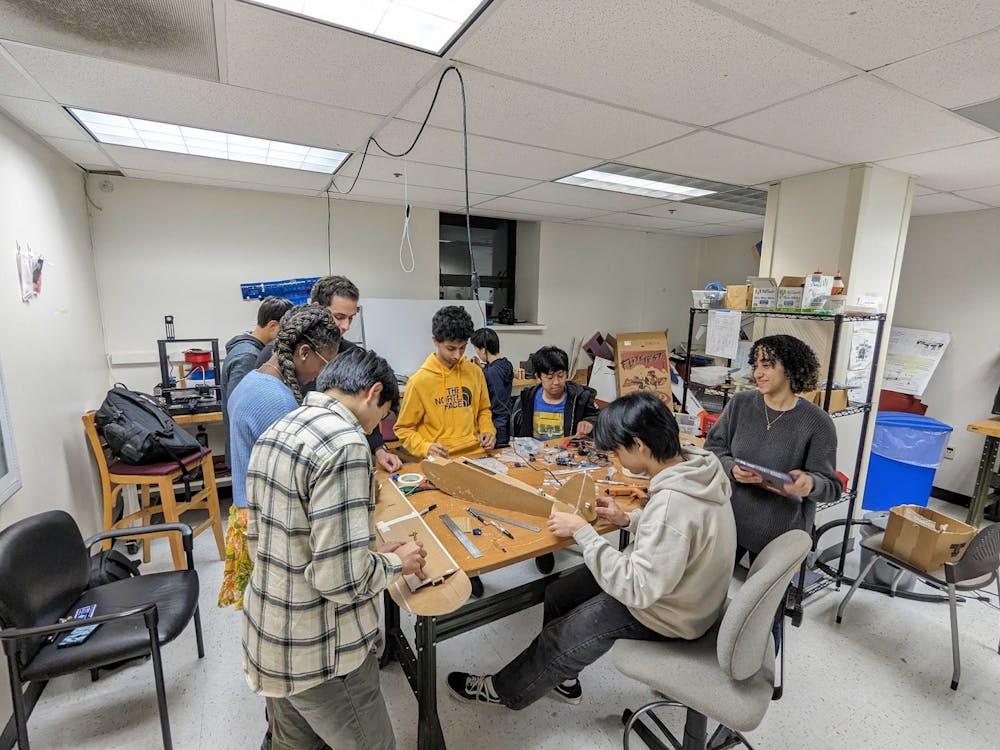Design, Build, Fly (DBF) at Hopkins designs remote-controlled airplanes to participate in the annual American Institute of Aeronautics and Astronautics Design Build Fly (AIAA DBF) competition. The club’s goal is to promote a collaborative environment where students work in teams to build a plane that aligns with the mission guidelines set out by AIAA.
Senior Emily Grace Kirkwood, the current president of the club, described the overarching mission of the organization and its history in an interview with The News-Letter.
"The group at Hopkins was organized in 2011 and began consistent participation in competitions around 2016 until COVID hit, and the group dissolved and became inactive for a year,” she said. “This year, we are in the process of rebuilding, and it's all hands on deck to prepare for the competition.”
Despite setbacks from the pandemic, the club's past success lays a foundation for reorganization. In 2020, the Hopkins DBF club placed 17th out of 101 universities that competed in the 24th AIAA competition.
The club’s alumni are also supportive of the group's efforts. Kirkwood described a memorable moment she cherishes.
"One time at the beginning of the semester, an alumni had come in and wrote an encouraging message on the board saying ‘keep it alive’, and I thought that was so sweet," she said.
In preparation for this year's competition, DBF is currently divided into two design teams, each generating ideas. Later, once the groups begin prototyping and building the competition plane, the design teams will split into subteams that focus on specific components of the plane.
In an interview with The News-Letter, club member Trevor Black discussed their progress this year.
"So far, we are mostly brainstorming, designing and building planes as they are quite large and take a lot of time to build. We are quite close to finishing one design, though, and I can't wait to move on to testing it,” he said. “Building the plane has entailed measuring, cutting and assembling foam boards to form the wings, body, etc. of the plane, as well as attaching electrical components such as servos, a rotor and a remote-control unit."
The subteam division is flexible depending on the number of people involved and the mission for a given year. Kirkwood provided a brief description of the division.
"There will be people focusing on Computer-Aided Design (CAD), others on electronics, wing design and mission-specific aspects," she said.
Although the competition generally involves remote-controlled airplanes, the missions each year are unique. For 2024, the competition is sponsored by Textron and involves simulating a scenario where the plane is transporting patients to a hospital. The evaluation will be based on the amount of transport, laps, and completion time. The DBF club will travel to Wichita, Kansas, in April 2024 for the 28th AIAA DBF Competition.
While DBF is a departmental club funded by the Department of Mechanical Engineering, its members come from various backgrounds, including computer science, material science and neuroscience. The diverse group of students is united by a shared interest in aeronautics.
Black shared that the community of aeronautics is one of the main aspects that prompted him to join the organization.
"I joined because I enjoy working on hands-on projects but have not done anything out of school arts-and-crafts projects before,” he said. “DBF is a great step up as there are very knowledgeable people who can teach me about the complex topics in aeronautics.”
Beyond its focus on the AIAA competition, DBF at Hopkins is committed to supporting students interested in designing radio-controlled (RC) planes. The club started with a group of students building airplanes for fun, and has now grown to become both a source of social connection and technical instruction for club members.
Black finds the teamwork aspect of the club a valuable experience through which he has bonded with his teammates.
"My favorite experience in the club was when we spent a few hours in a design competition where we split up into teams of four to rapidly prototype a plane,” he said. “While my team's plane wasn't the best by a long shot, it was still a lot of fun and quite useful to get used to working with the materials and working in groups."
Looking into the future, Kirkwood emphasized the importance of mentorship and her hopes for leaving a legacy that the underclassmen will carry on.
"My particular aim as president of the club would be to make sure we're set up well enough for success and longevity,” she said. “I want to make sure the underclassmen know how to keep things going and how to build a plane themselves when I graduate."
Editor’s Note, 2023: A previous version of this article misattributed the attached image.
The News-Letter regrets this error.





